In the domain of wedding floral arrangements, the subtle elegance of Hostas provides a unique and sophisticated touch. Known for their wide, textured leaves and delicate bell-shaped blooms, these herbaceous perennials offer a versatile palette with hues ranging from pristine white to soft lavender. As we explore the various aspects of incorporating Hostas into wedding decor, including their botanical characteristics, cultural significance, and ideal growing conditions, you will discover how these plants can transform a wedding setting into a beautiful, nature-inspired celebration. To truly appreciate the impact of Hostas, one must consider their multifaceted role in wedding aesthetics.
Flower Overview
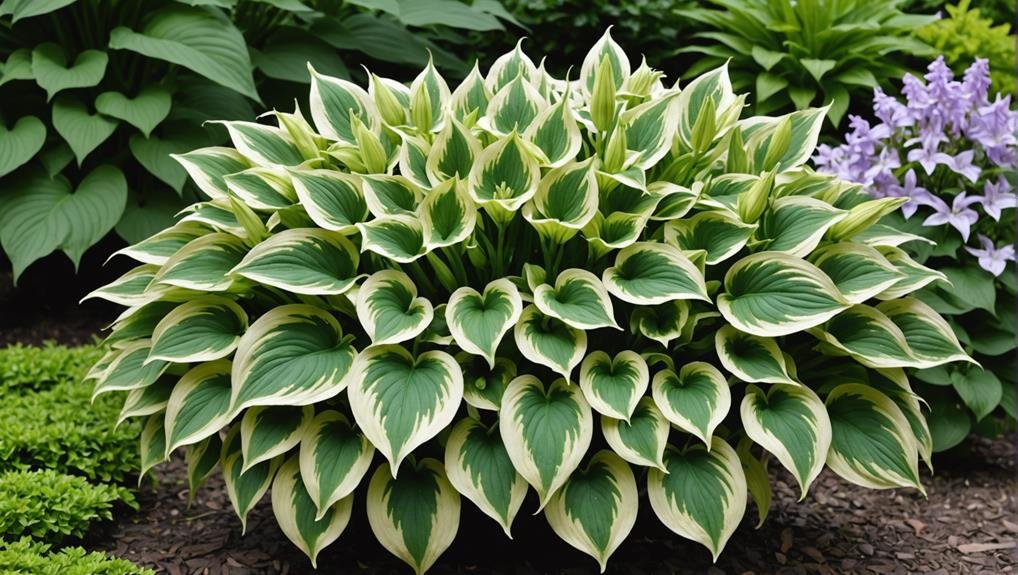
In the world of wedding florals, understanding the diverse characteristics and appeal of various flowers is essential for creating a memorable and cohesive aesthetic. Among the myriad options available, hosta flowers offer a unique charm, primarily due to their delicate, bell-shaped blooms. These flowers, ranging in shades from white to lavender, are typically used to make subdued yet elegant floral arrangements.
While hostas are generally celebrated for their lush foliage, their flowers provide an additional decorative element, blooming in mid to late summer and adding a touch of color to shaded areas.
It's important to keep in mind that hosta flowers are not only visually appealing but also fragrant, which can enhance the sensory experience of a wedding. Their scent can attract pollinators like bees and butterflies, which adds a natural and lively atmosphere to any garden setting.
When planning your wedding florals, you might consider incorporating hosta flowers for their subtle beauty and aromatic qualities.
For more detailed guidance and personalized advice on integrating hosta flowers into your wedding arrangements, please feel free to reach out via email address. Our team is dedicated to helping you create a stunning floral display for your special day.
Physical Description
Renowned for their lush and diverse foliage, hostas are herbaceous perennial plants that come in a variety of colors and textures. These plants are celebrated for their large, broad leaves which can range in size from a few inches to over a foot in length. The leaves exhibit an impressive array of textures; some varieties display corrugated or wavy patterns, adding an additional layer of visual interest to their appearance.
Hostas also produce tall spikes of bell-shaped flowers, typically blooming in the summer months. The flowers, which come in shades of white, lavender, or purple, rise above the foliage on slender stalks, creating a striking contrast against the dense leaves. This flowering feature enhances the ornamental value of hostas, making them a versatile choice for various garden applications.
With over 70 species and thousands of cultivars available, hostas offer a wide range of sizes, shapes, and textures to suit different landscape designs. They are often used as ground cover, border plants, or focal points in garden beds, providing both texture and color to outdoor spaces. This diversity allows for extensive customization in garden planning and aesthetic appeal.
Available Colour Varieties
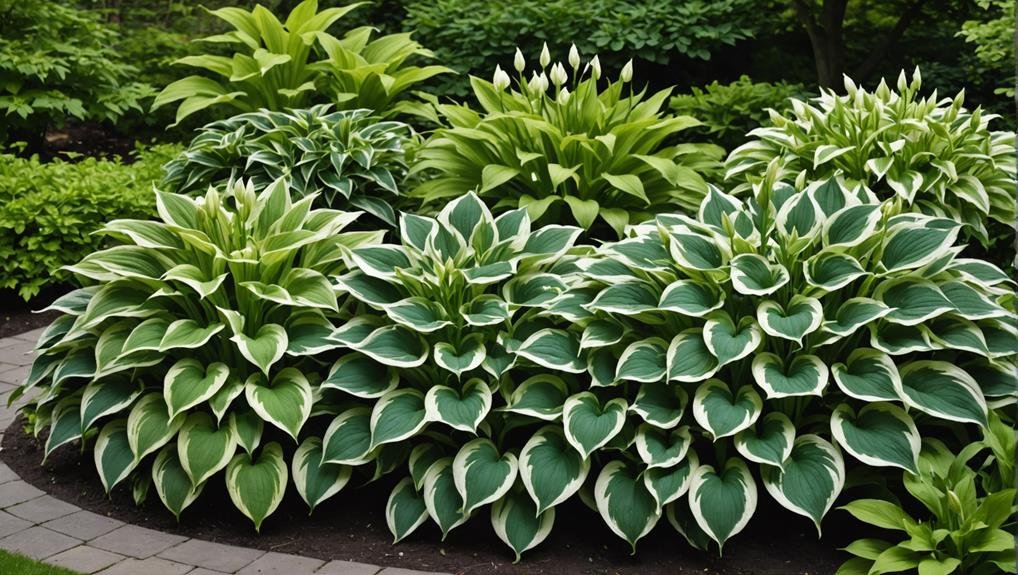
A remarkable aspect of hostas is their extensive range of color varieties, including shades of green, blue, yellow, and white. This diversity allows for stunning colour combinations that can be tailored to fit any wedding theme or aesthetic.
Hostas are particularly valued for their variegated leaves, which often feature striking patterns with two or more colors. Among the popular varieties, 'Golden Tiara' stands out with its yellow-green leaves, providing a warm and inviting accent. Meanwhile, 'Patriot' showcases green leaves edged with crisp white, offering a classic and elegant look. These popular varieties are frequently chosen for their distinctive appearances and their ability to complement other floral elements seamlessly.
Hostas also lend themselves well to unique arrangements, with their versatile foliage creating lush, textural backdrops or focal points in floral displays. For those seeking to create memorable and visually appealing wedding decor, mixing different color varieties of hostas can yield spectacular results.
Here are three popular combinations to contemplate:
- Green and White: Classic and timeless, perfect for traditional weddings.
- Yellow and Green: Warm and inviting, ideal for outdoor or summer ceremonies.
- Blue and Green: Cool and calming, suited for modern or minimalist themes.
These combinations guarantee that hostas remain a versatile and beloved choice for wedding flowers.
Latin Name and Taxonomy
How does one fully appreciate the Latin name and taxonomy of the versatile Hosta spp., a member of the Asparagaceae family? Understanding Hosta's botanical classification reveals its historical significance and the depth of its genetic diversity.
Named in honor of Austrian botanist Nicholas Thomas Host, the genus Hosta reflects a rich tapestry of taxonomic relationships and naming conventions. This appreciation is vital for comprehending the evolutionary adaptations that have enabled Hostas to thrive in various environments, making them a valuable addition to any garden or floral arrangement.
Hosta spp., commonly known as plantain lily or funkia, encompasses over 70 species and thousands of cultivated varieties. These varieties exhibit an impressive range of leaf colors, sizes, and shapes, highlighting the plant's remarkable genetic diversity.
The taxonomic relationships within the Asparagaceae family underscore the evolutionary pathways that have led to the Hosta's current form. This diversity is not only a tribute to the plant's adaptability but also to the intricate processes of botanical classification that have captured its essence.
Understanding the Latin name and taxonomy of Hosta spp. provides insight into its extensive historical significance and the evolutionary adaptations that continue to captivate botanists and horticulturists alike.
Geographical Origins
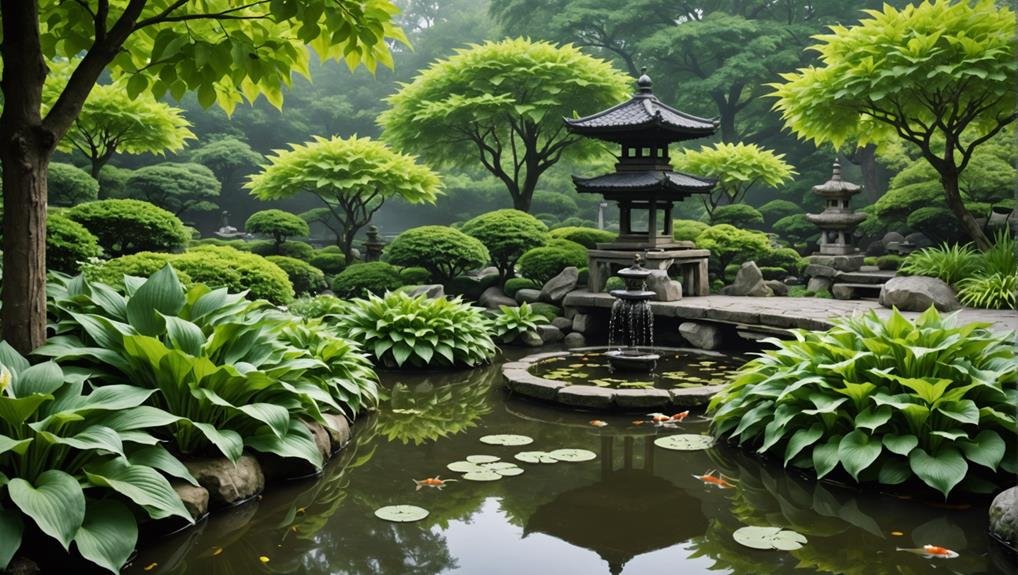
Building on the understanding of Hosta's botanical classification, it is essential to explore its geographical origins, which trace back to the temperate regions of Asia, particularly China, Korea, and Japan. These countries provide the ideal environments for Hosta species to thrive due to their temperate climates and rich, moist soils. The plant's native habitats include forested areas, riverbanks, and shaded hillsides, where they have adapted to various environmental conditions.
Hosta distribution across these regions highlights the plant's geographical diversity and adaptability. In China, Hostas are found flourishing in the understories of deciduous forests, while in Korea, they often inhabit shaded mountainous regions. Japan, known for its traditional gardens, has a long history of cultivating Hostas, where they are called 'Giboshi.'
Hostas have gained international popularity due to their attractive foliage and ease of care. This widespread appeal can be attributed to their rich history and diverse native habitats, which have allowed them to adapt to different growing conditions worldwide.
Here are three key points about Hosta's geographical origins:
- Native to China, Korea, and Japan
- Thrives in temperate climates
- Adaptable to various environmental conditions
Season Availability
Given their seasonal nature, Hosta plants are primarily available during the spring and summer months, making them a favored choice for weddings in these periods. This seasonal availability aligns perfectly with the peak wedding season, allowing couples to incorporate these lush, verdant plants into their floral arrangements with ease.
However, availability may vary depending on local climate factors. It is advisable to consult local nurseries or florists to confirm the specific availability of Hostas in your area.
For couples planning off-season weddings, indoor cultivation of Hostas offers a viable solution. Growing Hostas in containers indoors can extend their availability into the fall and winter months, providing flexibility for wedding dates outside the traditional growing season. Additionally, some Hosta varieties bloom in late summer, presenting an excellent option for early fall wedding arrangements.
When planning a wedding, it is essential to take into account local climate factors, as they can significantly impact the availability of Hostas. For those unable to source Hostas, alternative foliage options should be explored to maintain the desired aesthetic. This guarantees a cohesive and beautiful floral arrangement, regardless of the season.
Growing Conditions
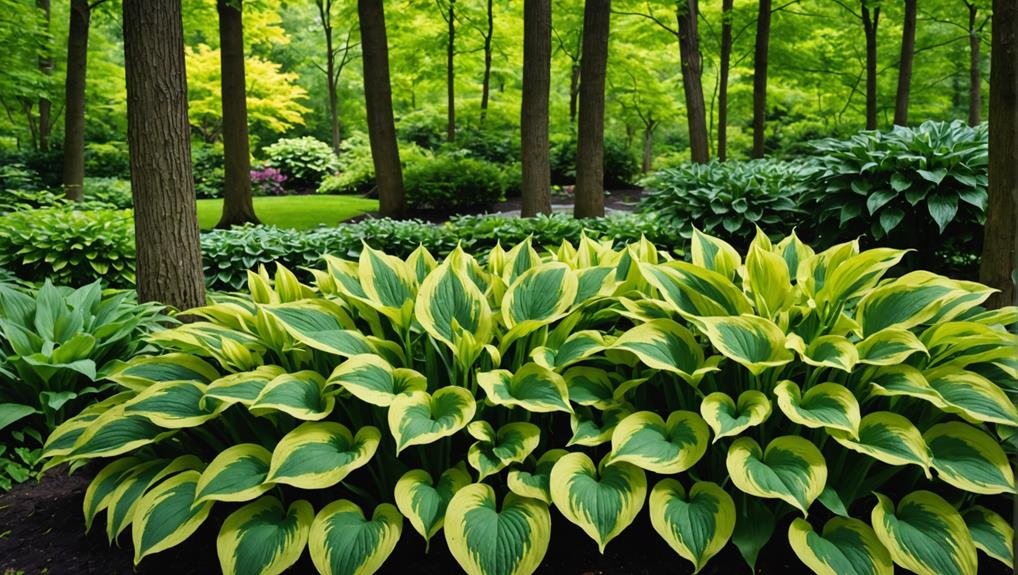
Understanding the best growing conditions for Hostas is fundamental to guaranteeing their successful incorporation into wedding floral arrangements. Hostas thrive in part to full shade conditions, making them ideal for areas with limited sunlight exposure. They require well-drained soil to prevent root rot and promote healthy growth. Maintaining these conditions is vital for preserving the plant's vibrant appearance and robust health.
When planning to grow Hostas, consider the following:
- Soil Requirements and Watering Schedule: Hostas prefer well-drained, fertile soil. A consistent watering schedule is essential, especially during dry spells, to keep the soil moist but not waterlogged.
- Ideal Planting Locations and Sunlight Exposure: Hostas flourish in areas with part to full shade, making them suitable for shaded garden beds or under trees where sunlight is limited.
- Preventing Root Rot and Promoting Healthy Growth: To prevent root rot, make sure the soil has good drainage. Regular trimming of stems post-bloom can promote new growth and maintain the plant's aesthetic appeal.
Cultural Significance
Hostas hold a prominent place in wedding floral arrangements due to their symbolic representation of devotion, friendship, and elegance. These symbolic meanings are deeply rooted in the characteristics of the plant itself. The lush green foliage of hostas is not just aesthetically pleasing but also carries profound connotations.
In many cultures, the plant's resilience and adaptability are equated with enduring love and commitment, essential qualities for a successful marriage.
Historically, hostas have been revered in various cultural customs for their long-lasting leaves and vibrant colors, which symbolize longevity and abundance. This symbolism aligns perfectly with the hopes and aspirations for a fruitful and enduring marriage.
In certain traditions, the inclusion of hosta leaves in wedding ceremonies has been seen as a way to invoke these qualities, ensuring a prosperous union.
Furthermore, hostas have been used in historical traditions not just for their beauty but also for their deeper meanings. They are often included in wedding decor to add a touch of natural sophistication and to enhance the overall ambiance of the celebration.
Typical Use in Weddings
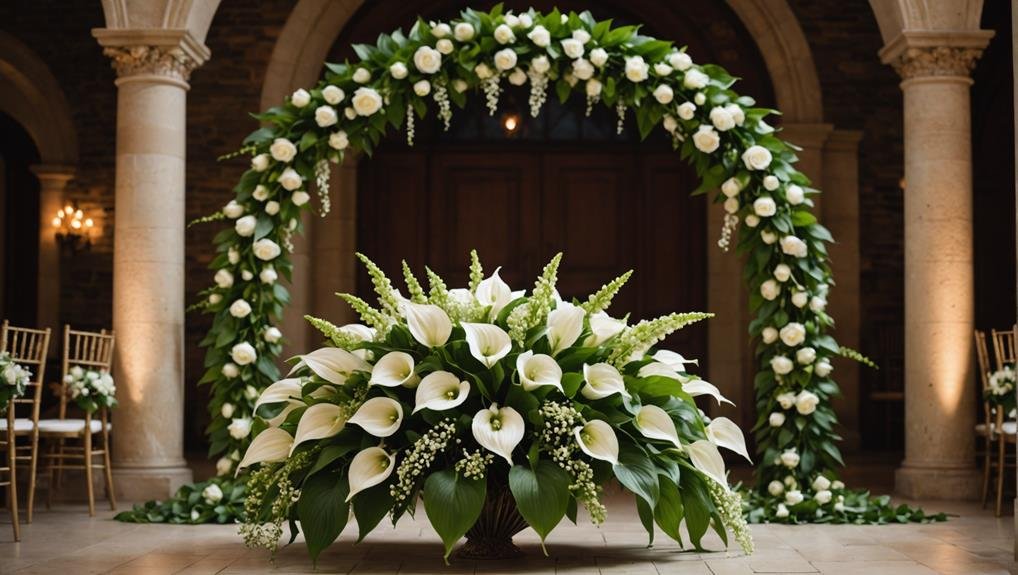
Incorporating hosta leaves into wedding floral arrangements not only enhances their symbolic significance but also provides practical benefits due to their lush, green foliage and versatile nature. These leaves are commonly used to add texture and depth to various wedding decorations, making them an excellent choice for unique arrangements and creative bouquets.
Hosta leaves serve multiple purposes in wedding decor:
- Table decorations and Ceremony backdrops: Their large size and vibrant green color provide a fresh, organic element that can be used to create stunning centerpieces or lush ceremony backdrops.
- Bridesmaid accessories and Reception decor: Hosta leaves can be integrated into bridesmaid bouquets or used to accentuate reception decor, adding a cohesive and elegant touch to the overall aesthetic.
- Unique arrangements and Creative bouquets: Their durability and long-lasting quality make them ideal for creating unique arrangements that stay fresh throughout the event.
The versatility of hosta leaves allows them to complement a variety of flower types and colors, ensuring they blend seamlessly with any wedding theme. Their lush foliage not only stands out but also enhances the beauty and sophistication of the floral designs, making them a popular choice among wedding florists.
Alternative Flower Types
Exploring alternative flower types such as Astilbe, Bleeding Heart, and Coral Bells can diversify and enrich wedding floral arrangements with unique textures and vibrant colors. Astilbe offers feathery plumes in shades of pink, white, and red, adding a soft, romantic touch to bouquets and centerpieces. These delicate flowers can serve as both focal points and fillers, introducing a light, airy element to any arrangement.
Bleeding Heart, with its heart-shaped flowers in pink or white, symbolizes love and tenderness, making it ideal for a whimsical and delicate wedding theme. Its distinctive shape provides bouquet inspiration, adding a unique touch to traditional designs.
Coral Bells, known for their colorful foliage and dainty bell-shaped flowers, bring a vibrant pop of color and texture to floral arrangements. Their versatility allows for creative pairings with other flowers, including Hosta, to create unique arrangements that stand out.
